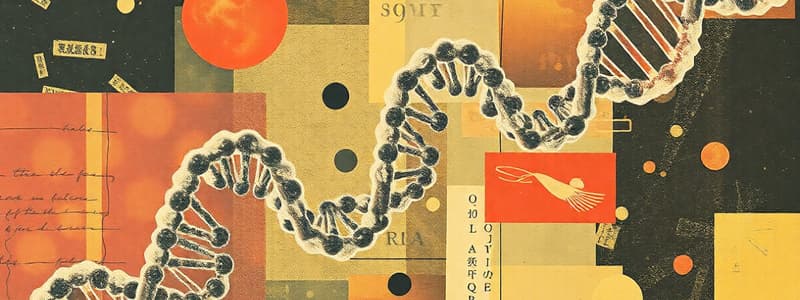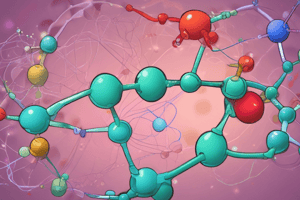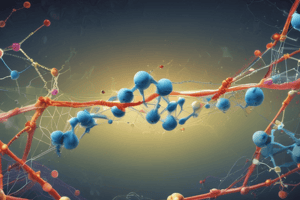Podcast
Questions and Answers
What is the primary structure that forms the backbone of nucleic acids?
What is the primary structure that forms the backbone of nucleic acids?
- Fatty acid chains
- Sugars linked to phosphates (correct)
- Steroid rings
- Amino acid sequences
What role do histone proteins play in relation to DNA?
What role do histone proteins play in relation to DNA?
- They negatively charge DNA strands
- They neutralize and store negatively charged DNA (correct)
- They help synthesize RNA
- They facilitate nucleotide modifications
Which enzyme is responsible for synthesizing RNA?
Which enzyme is responsible for synthesizing RNA?
- RNA polymerase (correct)
- DNA polymerase
- Reverse transcriptase
- RNA ligase
What is the first nucleotide in a growing nucleic acid strand incorporated into the chain?
What is the first nucleotide in a growing nucleic acid strand incorporated into the chain?
What mechanism is employed by some DNA polymerases to correct nucleotide errors?
What mechanism is employed by some DNA polymerases to correct nucleotide errors?
What is the consequence of deamination in nitrogenous bases?
What is the consequence of deamination in nitrogenous bases?
What type of bond do exonucleases hydrolyze to remove nucleotides?
What type of bond do exonucleases hydrolyze to remove nucleotides?
Which occurs when a nucleic acid grows?
Which occurs when a nucleic acid grows?
What role do pi interactions play in the structure of DNA?
What role do pi interactions play in the structure of DNA?
Which of the following is true about RNA's structure during transcription?
Which of the following is true about RNA's structure during transcription?
What characterizes the helical structure formed by RNA folding on itself?
What characterizes the helical structure formed by RNA folding on itself?
Which of the following accurately describes the representation of tRNA structures?
Which of the following accurately describes the representation of tRNA structures?
What do Chargaff’s rules specify regarding the composition of DNA?
What do Chargaff’s rules specify regarding the composition of DNA?
Which statement is true regarding RNA's biological functions?
Which statement is true regarding RNA's biological functions?
How are the phosphodiester bonds represented in RNA structures?
How are the phosphodiester bonds represented in RNA structures?
In which conformation do bases in a DNA double helix primarily reside?
In which conformation do bases in a DNA double helix primarily reside?
What is the pairing rule for purines and pyrimidines in DNA?
What is the pairing rule for purines and pyrimidines in DNA?
Chargaff's rules apply to which type of nucleic acid structure?
Chargaff's rules apply to which type of nucleic acid structure?
If a double-stranded DNA molecule contains 200 base pairs and 97 guanine bases, how many thymine bases are present?
If a double-stranded DNA molecule contains 200 base pairs and 97 guanine bases, how many thymine bases are present?
Which statement is true regarding base pairing within RNA?
Which statement is true regarding base pairing within RNA?
What environmental condition can disrupt the stability of nucleic acid secondary structures?
What environmental condition can disrupt the stability of nucleic acid secondary structures?
In a DNA-RNA complex, how do the bases pair when adenine is present?
In a DNA-RNA complex, how do the bases pair when adenine is present?
What is the optimal pH for DNA annealing?
What is the optimal pH for DNA annealing?
What occurs during wobble pairing in tRNA?
What occurs during wobble pairing in tRNA?
What type of bond is formed during nucleotide polymerization?
What type of bond is formed during nucleotide polymerization?
Which group of the nucleotide reacts with the phosphate group of another nucleotide?
Which group of the nucleotide reacts with the phosphate group of another nucleotide?
Which of the following correctly describes nucleoside triphosphate (NTP) in nucleotide polymerization?
Which of the following correctly describes nucleoside triphosphate (NTP) in nucleotide polymerization?
What is released during the condensation reaction in nucleotide polymerization?
What is released during the condensation reaction in nucleotide polymerization?
What is the sequence of a nucleic acid traditionally written from?
What is the sequence of a nucleic acid traditionally written from?
How is a dinucleotide formed?
How is a dinucleotide formed?
What term is used to describe nucleic acids that contain a few nucleotides?
What term is used to describe nucleic acids that contain a few nucleotides?
What is the significance of the carbon numbering system in nucleotides?
What is the significance of the carbon numbering system in nucleotides?
What is the function of DNA ligase in nucleotide repair?
What is the function of DNA ligase in nucleotide repair?
What is the primary structure of a nucleic acid composed of?
What is the primary structure of a nucleic acid composed of?
Which base pairing occurs in DNA?
Which base pairing occurs in DNA?
What structural feature contributes to the stability of the DNA double helix?
What structural feature contributes to the stability of the DNA double helix?
What is meant by the term 'antiparallel orientation' of DNA strands?
What is meant by the term 'antiparallel orientation' of DNA strands?
What role does the hydrophobic effect play in the structure of DNA?
What role does the hydrophobic effect play in the structure of DNA?
What occurs if there is a single mismatch in base pairing during DNA annealing?
What occurs if there is a single mismatch in base pairing during DNA annealing?
Which of the following accurately describes complementary bases in DNA?
Which of the following accurately describes complementary bases in DNA?
How does a change in pH affect the functional groups in bases?
How does a change in pH affect the functional groups in bases?
What role do histones play in eukaryotic DNA structure?
What role do histones play in eukaryotic DNA structure?
Which factor has the greatest impact on the melting temperature (Tm) of a double helix?
Which factor has the greatest impact on the melting temperature (Tm) of a double helix?
What occurs to the strands of a double helix when subjected to higher temperatures?
What occurs to the strands of a double helix when subjected to higher temperatures?
What is the significance of GC content in a double helix?
What is the significance of GC content in a double helix?
What is the melting temperature (Tm) in the context of DNA?
What is the melting temperature (Tm) in the context of DNA?
How do salts influence DNA stability?
How do salts influence DNA stability?
In the context of PCR, what is manipulated to optimize the melting temperature?
In the context of PCR, what is manipulated to optimize the melting temperature?
Flashcards
What are nucleic acids made of?
What are nucleic acids made of?
Nucleic acids, like DNA and RNA, are polymers formed by linking nucleotides together.
How are nucleotides linked in nucleic acids?
How are nucleotides linked in nucleic acids?
The 3' hydroxyl group of one nucleotide reacts with the 5' phosphate group of another nucleotide, forming a phosphodiester bond.
What are the ends of a nucleic acid called?
What are the ends of a nucleic acid called?
The end of a nucleic acid with a free 5' phosphate group is called the 5' end, while the end with a free 3' hydroxyl group is called the 3' end.
What is released during nucleic acid synthesis?
What is released during nucleic acid synthesis?
Signup and view all the flashcards
How is nucleic acid sequence written?
How is nucleic acid sequence written?
Signup and view all the flashcards
What are short and long nucleic acids called?
What are short and long nucleic acids called?
Signup and view all the flashcards
What are the components of a nucleotide?
What are the components of a nucleotide?
Signup and view all the flashcards
What is nucleic acid polymerization ?
What is nucleic acid polymerization ?
Signup and view all the flashcards
What is the primary structure of a nucleic acid?
What is the primary structure of a nucleic acid?
Signup and view all the flashcards
What is the secondary structure of a nucleic acid?
What is the secondary structure of a nucleic acid?
Signup and view all the flashcards
What is the most well-known secondary structure in nucleic acids?
What is the most well-known secondary structure in nucleic acids?
Signup and view all the flashcards
What is annealing of DNA strands?
What is annealing of DNA strands?
Signup and view all the flashcards
What is the orientation of DNA strands in a double helix?
What is the orientation of DNA strands in a double helix?
Signup and view all the flashcards
What are complementary base pairs?
What are complementary base pairs?
Signup and view all the flashcards
How does the hydrophobic effect contribute to DNA structure?
How does the hydrophobic effect contribute to DNA structure?
Signup and view all the flashcards
How does base pairing affect DNA stability?
How does base pairing affect DNA stability?
Signup and view all the flashcards
What is a nucleic acid?
What is a nucleic acid?
Signup and view all the flashcards
Describe the structure of a nucleic acid backbone.
Describe the structure of a nucleic acid backbone.
Signup and view all the flashcards
Which enzymes are involved in nucleic acid synthesis?
Which enzymes are involved in nucleic acid synthesis?
Signup and view all the flashcards
How are the 5' and 3' ends of a nucleic acid defined?
How are the 5' and 3' ends of a nucleic acid defined?
Signup and view all the flashcards
Describe the mechanism of nucleic acid elongation.
Describe the mechanism of nucleic acid elongation.
Signup and view all the flashcards
How are errors in DNA synthesis corrected?
How are errors in DNA synthesis corrected?
Signup and view all the flashcards
Describe the process of repairing a deaminated base in DNA.
Describe the process of repairing a deaminated base in DNA.
Signup and view all the flashcards
Chargaff's Rules in DNA-RNA Complex
Chargaff's Rules in DNA-RNA Complex
Signup and view all the flashcards
pH and DNA Annealing
pH and DNA Annealing
Signup and view all the flashcards
Hydrogen Bonding in DNA Stability
Hydrogen Bonding in DNA Stability
Signup and view all the flashcards
Environmental Factors and DNA Stability
Environmental Factors and DNA Stability
Signup and view all the flashcards
Chargaff's Rules: Purines and Pyrimidines
Chargaff's Rules: Purines and Pyrimidines
Signup and view all the flashcards
Chargaff's Rules: Double-Stranded DNA
Chargaff's Rules: Double-Stranded DNA
Signup and view all the flashcards
Chargaff's Rules in RNA
Chargaff's Rules in RNA
Signup and view all the flashcards
Chargaff's Rules in DNA-RNA Pairing
Chargaff's Rules in DNA-RNA Pairing
Signup and view all the flashcards
Why does DNA form a double helix?
Why does DNA form a double helix?
Signup and view all the flashcards
What is pi stacking and why is it important for DNA?
What is pi stacking and why is it important for DNA?
Signup and view all the flashcards
How can RNA form different structures?
How can RNA form different structures?
Signup and view all the flashcards
What are Chargaff's rules?
What are Chargaff's rules?
Signup and view all the flashcards
Optimal pH for DNA stability
Optimal pH for DNA stability
Signup and view all the flashcards
What is the basis of Chargaff's rules?
What is the basis of Chargaff's rules?
Signup and view all the flashcards
How phosphate groups affect DNA stability
How phosphate groups affect DNA stability
Signup and view all the flashcards
Role of histones in DNA stability
Role of histones in DNA stability
Signup and view all the flashcards
What is the primary structure of DNA?
What is the primary structure of DNA?
Signup and view all the flashcards
What is the secondary structure of DNA?
What is the secondary structure of DNA?
Signup and view all the flashcards
How salts influence DNA stability
How salts influence DNA stability
Signup and view all the flashcards
What is the tertiary structure of RNA?
What is the tertiary structure of RNA?
Signup and view all the flashcards
Effect of temperature on DNA stability
Effect of temperature on DNA stability
Signup and view all the flashcards
Melting temperature (Tm)
Melting temperature (Tm)
Signup and view all the flashcards
How GC content affects Tm
How GC content affects Tm
Signup and view all the flashcards
Importance of Tm in PCR
Importance of Tm in PCR
Signup and view all the flashcards
Study Notes
Nucleic Acid Formation
- Nucleic acids are polymers formed from nucleotides
- DNA and RNA are two types of nucleic acids
- Nucleotides are composed of a sugar, a phosphate group, and a nitrogenous base
- The carbons in the sugar component are numbered using a prime symbol (')
- Nucleic acids form when the 3' hydroxyl group of one nucleotide reacts with the 5' phosphate group of another
- This forms a phosphodiester bond, linking the nucleotides
- The reaction is a condensation reaction, where pyrophosphate (PP) is released instead of water
- The 5' end of a nucleic acid has a free phosphate group
- The 3' end has a free hydroxyl group
- Nucleic acid sequences are written in the 5' to 3' direction
Base Pairing and Secondary Structure
- The sequence of nucleotides is the primary structure of a nucleic acid
- Nucleic acids can form secondary structures, such as the double helix in DNA
- In DNA, two strands twist around each other forming a double helix structure
- The strands are anti-parallel, meaning the 3' end of one strand aligns with the 5' end of the other
- Hydrogen bonds between complementary bases (A-T and G-C) hold the two strands together
- This gives complementary bases
- Base pairing in nucleic acids follows Chargaff's rules:
- The number of adenine bases equals the number of thymine bases
- The number of guanine bases equals the number of cytosine bases
- The sum of purines equals the sum of pyrimidines
- These rules only apply to double-stranded nucleic acids
Double Helix Stability
- Nucleic acid secondary structure can be disrupted by environmental factors (pH, salt, temperature)
- Optimal pH for DNA annealing is near 7.4
- Higher temperatures cause the hydrogen bonds holding the helix together to break, causing denaturation
- Melting temperature (Tm) is the temperature at which 50% of the double helices in a solution denature
- Higher GC content results in a higher melting temperature (Tm)
- The melting curve's sigmoidal shape indicates cooperative denaturation, where separation of portions of the helix becomes easier as more portions separate
Studying That Suits You
Use AI to generate personalized quizzes and flashcards to suit your learning preferences.




